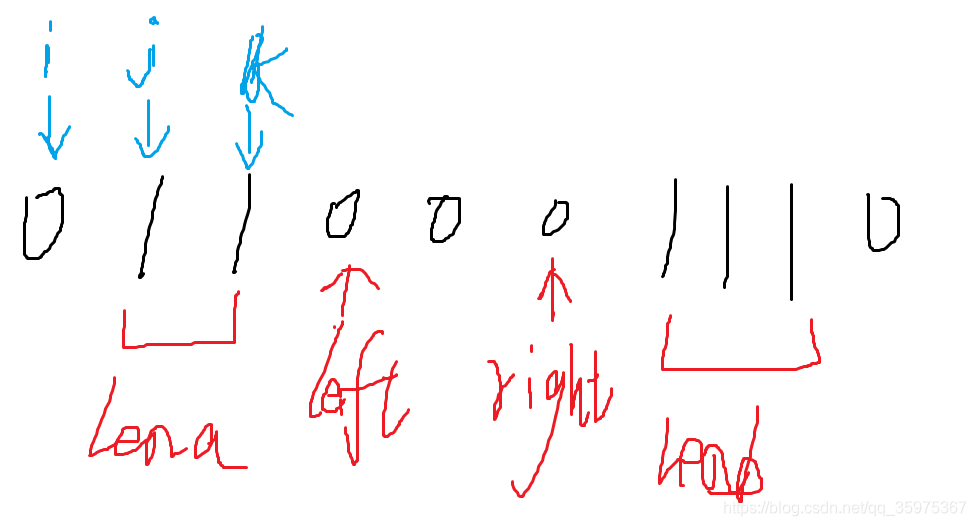H - Checker FZU - 2041
题意:
一个长度为n的01串,现在能将里面的1移动m次,问最长的连续0是多长
题解:
没想出来,看了其他人代码,就是对于每个0空间进行扩充,然后记录每次扩充的最大值
关键在于扩充的细节:
我们每次锁定一个连续的0的左右端点(图中的left和right)
然后看left和right分别向外找最近的0,我们可以通过下图看出,左侧长度为lena可以找到0,右侧lenb可以找到0,lena<lenb,所以我们移动左侧
每次移动也是缓慢移动,我们让i和j进行交换,然后看left-1(即k的位置)是否为0,如果是0,left就向左移动,相当于扩大区间,
为什么要先交换i和j呢?因为要扩大范围,只能先换走j,再换走k,一步一步来,不能着急,每次移动都会消耗步数

这个思路很妙
代码:
#include <cstdio>
#include <iostream>
#include <cstring>
#include <string>
#include <algorithm>
#include <cmath>
#include <vector>
using namespace std;typedef long long LL;
const double eps = 1e-6;
const int INF = 0x3f3f3f3f;
const int MAXN = 500 + 10;
int t, len, step;
char G[MAXN], CG[MAXN];int Calc(int left, int right) {strcpy(CG, G);int cnt = step;int low = left - 1, high = right + 1;while (cnt--) {if (low - 1 < 0 && high + 1 >= len) break;for (;;) {if (low - 1 < 0 && high + 1 >= len) break;int lena = INF, lenb = INF;bool yes = false;if (low - 1 >= 0 && CG[low - 1] == '0') {//记录两个0之间相隔1的数量 lena = left - (low - 1);yes = true;} if (high + 1 < len && CG[high + 1] == '0') {lenb = high + 1 - right;yes = true;}if (!yes) {//如果low和high还没找到0,继续向外找 --low;++high;continue;}if (lena < lenb) {//相隔1最少的 swap(CG[low], CG[low - 1]);if (CG[left - 1] == '0') {//查看left是否可以向左扩展 --left;}} else {swap(CG[high], CG[high + 1]);if (CG[right + 1] == '0') {++right;}}low = left - 1;high = right + 1;break;}}return right - left + 1;
}int main() {scanf("%d", &t);int cas = 0;while (t--) {scanf("%d%d%s", &len, &step, G);int ans = 0;for (int i = 0; i < len;) {if (G[i] == '0') {int j = i;while (j + 1 < len && G[j + 1] == '0') { ++j; }//每次找到连续0的左右端点 ans = max(ans, Calc(i, j));i = j + 1;} else {++i;}}printf("Case %d: %d\n", ++cas, ans);}return 0;
}



)

)

GPIO 的使用)

(二分图))
![[2021.4.7多校省选模拟33]A,B,C](http://pic.xiahunao.cn/[2021.4.7多校省选模拟33]A,B,C)

![P5044-[IOI2018] meetings 会议【dp,笛卡尔树,线段树二分】](http://pic.xiahunao.cn/P5044-[IOI2018] meetings 会议【dp,笛卡尔树,线段树二分】)



![[CF/AT]各大网站网赛 体验部部长第一季度工作报告](http://pic.xiahunao.cn/[CF/AT]各大网站网赛 体验部部长第一季度工作报告)
)
![P7520-[省选联考 2021 A 卷]支配](http://pic.xiahunao.cn/P7520-[省选联考 2021 A 卷]支配)
